The single biggest difference between this saw and other printer's saws is that in most printer's saws the entire portion of the table to the left of the sawblade slides on dovetail ways. In other words, the work is fixed to the table, and the table moves. In the C&G/Morrison saw, the table is a single solid piece (much like a conventional table saw) and the work moves while clamped to a sliding guide.
Most other printers' saws place the work in front of the pica-graduated guide as it moves towards the sawblade. In this saw, however, the work is place behind the guide (that is, on the side toward the user). A ratcheting clamp holds it in place.
There are several photographs of saws very similar to mine online at the Old Woodworking Machines website. In particular, see:
Note that as this is a woodworking machine site, they have no idea what a printer's saw is and refer to it as a "tenoning machine."
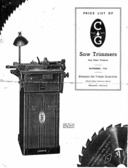
Price List of C&G Saw Trimmers (1938)
Price List of C & G Saw Trimmers And Other Products (Milwaukee, WI: Milwaukee Saw Trimmer Corporation, November, 1938). An eight-page brochure, scanned from a photocopy.
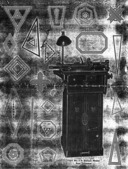
C&G No. 3A Deluxe
C & G No. 3-A Deluxe Model Saw Trimmer (Milwaukee, WI: Milwaukee Saw Trimmer Corporation, [no date]). An eight-page brochure, scanned from a photocopy.
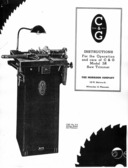
Instructions for ... Model 3A Saw Trimmer
Instructions for the Operation and care of C & G Model 3A Saw Trimmer (Milwaukee, WI: The Morrison Company, [no date; after postal zone codes (1943) but before ZIP codes (1963)]). A six-page manual, scanned from a photocopy.
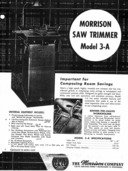
Morrison Saw Trimmer Model 3-A
Morrison Saw Trimmer Model 3-A (Milwaukee, WI: The Morrison Company, [no date; after postal zone codes (1943) but before ZIP codes (1963)]). A two-page sales flyer, scanned from a photocopy.

C&G Sawliner
Four-page brochure for the C&G "Sawliner" model printer's saw. This must date from the early 1940s, both on the basis of appearance and because (a) the "Sawliner" is not mentioned in the 1938 price list, above, but (b) the present document does not use postal zone codes in its address. (Zone codes were introduced in 1943, but were not mandatory; later Morrison Company documents did use them.) The Sawliner is not mentioned in the 1953 Western Newspaper Union catalog (see below). (see below).

American Wood Type Manufacturing Co.
Morrison Saw Trimmers were sold in at least one catalog of the American Wood Type Manufacturing Company.
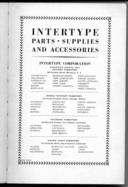
Intertype Parts
Some not-very-good older scans I did from the 1932 Intertype Parts, Supplies and Accessories catalog. I should re-do these. They show the C&G "Trimmiter" composing room saw and mitering machine, in No. 1 and "AdAlley" models.

Star Parts (1956/1966)
A page from a Star Parts catalog. The page date is Oct. 1956, but the catalog itself is the 1966 binder. This shows the Deluxe Saw Trimmer and Slug Stripper, sold here under the Morrison name only.

Steward Company
Morrison Saw Trimmers were sold in at least one catalog of the Steward Company (San Francisco and Los Angeles).
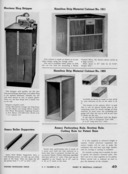
WNU Catalogue No. 53: Slug Stripper
Western Newspaper Union Catalogue No. 53, p. 49: Morrison Slug Stripper.
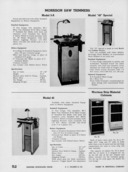
WNU Catalogue No. 53: Saw Trimmers 3A and 45
Western Newspaper Union Catalogue No. 53, p. 52: Morrison Saw Trimmers, Models 3A and 45.
The patents reprinted here are those of Cheshire's for composing room saws and related equipment. He was also issued several patents for sheet feeding devices. These include:
Also, in addition to the saw patents reprinted here, my C&G saw indicates that he was issued Australian patent 11,929. I have not yet located this.
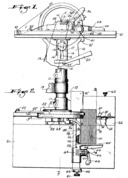
US Patent 1,463,545. Cutting Mechanism
United States patent 1,463,545. Issued 1923-07-31. Filed 1921-01-21 as application serial number 438,813. Edward Cheshire. "Cutting Mechanism." Not assigned.
"The invention finds particular application in connection with sawing and trimming linotype slugs, mitering borders, and sawing and trimming cuts or electrotypes for printers' use. ..."
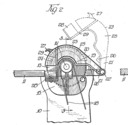
US Patent 1,495,248. Saw Guard
United States patent 1,495,248. Issued 1924-05-27. Filed 1922-01-27 as application serial number 532,208. Edward Cheshire. "Composing-Room Saw." Not assigned.
"... to provide a simple and practical saw guard having guide means normally in operative association with the saw for directing and carrying away waste material from the saw."
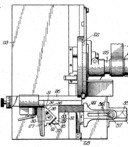
US Patent 1,506,407. Saw Mitering Arrangement
United States patent 1,506,407. Issued 1924-08-24. Filed 1922-03-06 as application serial number 541,309. Edward Cheshire. "Composing-Room-Saw Mitering Arrangement."
"It is found that borders cast in type casting machines at times vary in thickness from 1/1000 to 5/1000 of an inch from the standard. Accordingly, standard gauges do not always give a setting for accurately mitering." "One object .. is to provide simple and reliable means for making an accurate setting for borders and the like so that same may be accurately mitered."
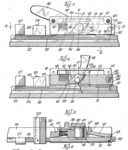
US Patent 1,618,170. Saw Workholding Clamp
United States patent 1,618,170. Issued 1927-02-22. Filed 1923-09-15 as application serial number 662,840. Edward Cheshire. "Composing-Room Saw." Not assigned.
"This invention relates to a composing room saw and more particularly to means for clamping line-o-type slugs, borders, cuts or electroplates and the like."
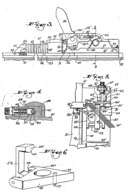
GB Patent 217,638. Machine Vices.
British patent 217,638. Accepted 1924-06-16. Filed 1923-03-15 as application No. 7533/28. Edward Cheshire. "Improvements in Machine Vices."
"This invention relates to improvements in machine vices of the type which are more particularly adapted for use in connection with sawing and trimming slugs, mitering borders, and sawing and trimming cuts or electrotypes for printers' use."

US Patent 1,807,896. Vise.
United States patent 1,807,896. Issued 1931-06-02. Filed 1927-07-25 as application serial number 208,077. Edward Cheshire. "Vise." Not assigned.
The vise is described as "portable," secure, and "inexpensive." It is intended for and shown in conjunctio with "router, jig-saw and type-high machine[s.]" In earlier patents, Cheshire gives his residence as Waukesha County, Wisconsin. By the time of this patent, he has moved to Florida.
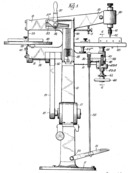
US Patent 1,812,685. Combined Machine.
United States patent 1,812,685. Issued 1931-06-30. Filed 1927-06-03 as application serialnumber 196,196. Edward Cheshire. "Composing Room Machine." Not assigned.
"The present invention contemplates a combined machine having the functions of a router, type-high machine, drill, jig-saw and broacher..."
I acquired a "C & G" printer's saw in 2008 from the grandson of Victor Edwards (1919-). He in turn had acquired it when he purchased Empire Typesetting in Chicago in 1958, as a part of the shop. The shop was originally the Stigner School of Typesetting and its associated job shop. It was located in the basement of the Leahy Building at the northwest corner of Ontario and Franklin, in Chicago. This saw operated in his shop until it shut down in the mid-1970s (by that time, sensing the commercial demise of hot metal typesetting, he had renamed his business, quite poetically, "Elegy Typesetting.") He operated it as a job shop, and had three Linotypes. Mr. Edwards learned his trade at the Methodist Publishing House, and later worked at the Chicago Tribune in the composing room, doing display ads. During the transition from hot metal to phototypesetting, he was also a field engineer installing Ludlow "Bright Type" equipment. Unfortunately, I never had the opportunity to meed Mr. Edwards, but greatly appreciate learning the history of this saw from his son and grandson.
Thanks are due to Mr. Edwards' grandson for making the effort to ensure that this saw remained within the printing community (rather than simply selling it at a garage sale or, worse, junking it). If more people did this, printing and the history of printing would be in better shape.
As acquired, my saw is missing the mitering attachment (which I know was originally present, since I was told that they did quite a bit of mitering on this saw) and the attachments for grinding. The guard for the grinding wheel was also shattered, and the grinding attachment is missing. Otherwise, it is quite functional.
All of the C&G / Morrison / Milwaukee literature reprinted here was published in the US without copyright notice at a time when such notice was required to secure copyright. It therefore passed into the public domain upon initial publication. The digital reprint of it here remains in the public domain.
The 1932 Intertype Parts and Accessories Book was published in the US before 1978 without copyright notice, and so passed into the public domain upon publication. The images presented here remain in the public domain.
The 1966 Star Parts catalog binder in which the 1956 Morrison ad reproduced here appeared was copyright 1963. This copyright was not renewed, as would then have been required, and so this lapsed into the public domain upon the expiration of its original copyright. The digital reprint of it here remains in the public domain.
The WNU Catalogue No. 53 extracted from here was published in the United States without copyright notice at a time when such notice was required to secure copyright. It therefore passed into the public domain upon initial publication. These digital extracts remain in the public domain.
British patents issued before Aug. 1, 1989 were subject to Crown Copyright for a period of 50 years. The original version of the patent reproduced here is therefore in the public domain. The source documents used here is the PDF presented by the UK Intellectual Property Office via ESP@CENET. I can find no indication at all in their presentation that any additional copyright has been asserted for it. I believe, therefore, that they are in the public domain.
United States patent specifications are in the public domain.
All portions of this document not noted otherwise are Copyright © 2008, 2010 by David M. MacMillan and Rollande Krandall.
Circuitous Root is a Registered Trademark of David M. MacMillan and Rollande Krandall.
This work is licensed under the Creative Commons "Attribution - ShareAlike" license. See http://creativecommons.org/licenses/by-sa/3.0/ for its terms.
Presented originally by Circuitous Root®
Select Resolution: 0 [other resolutions temporarily disabled due to lack of disk space]